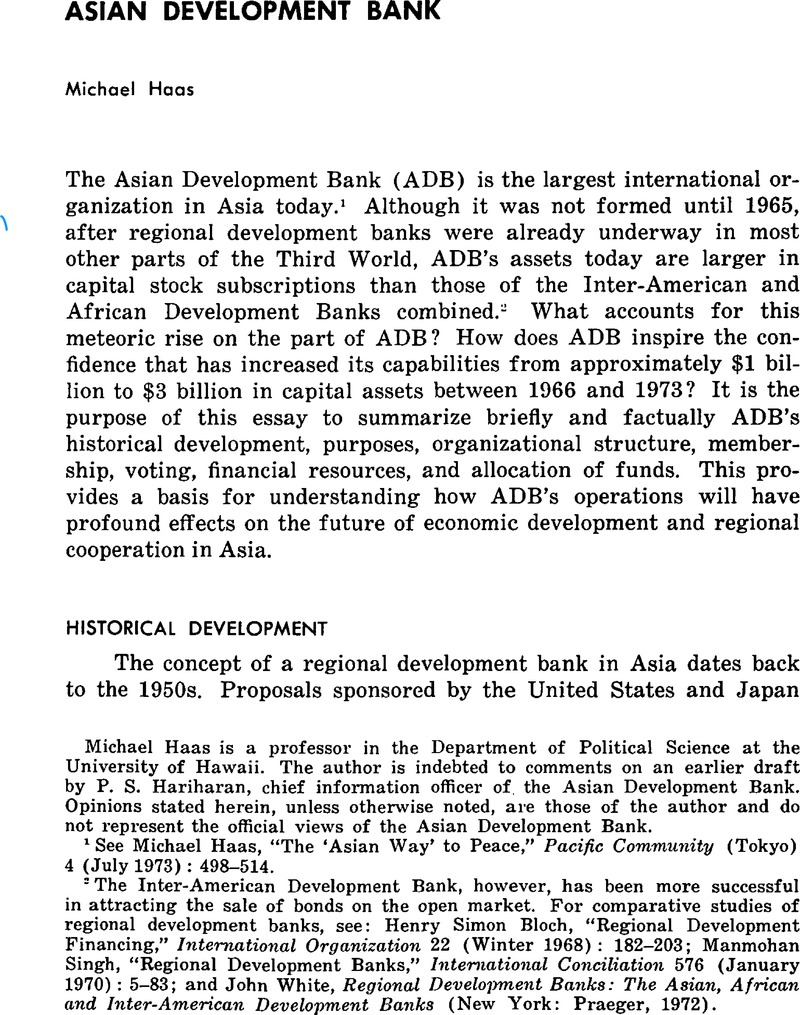Published online by Cambridge University Press: 22 May 2009

1 See Haas, Michael, “The ‘Asian Way’ to Peace,” Pacific Community (Tokyo) 4 (July 1973): 498–514.Google Scholar
2 The Inter-American Development Bank, however, has been more sucessful in attracting the sale of bonds on the open market. For comparative studies of regional development banks, see: Bloch, Henry Simon, “Regional Development Financing”, International Organization 22 (Winter 1968): 182–203CrossRefGoogle Scholar;Singh, Manmohan, “Regional Development Banks”, International Conciliation 576 (January 1970): 5–83Google Scholar; and White, John, Regional Development Banks: The Asian, African and Inter-American Development Banks (New York: Praeger, 1972).Google Scholar
3 For example, the Simla Conference of 1955 and Prime Minister Kishi's proposals of 1957. Yet another scheme for an Asian development bank was discussed in informal channels in Tokyo in 1962–63; Takeshi Watanabe presented this idea to Eugene Black, former president of the World Bank, in 1963, but Black indicated that Washington was not ready to support such an idea. See Po-Wen Huang, Jr., The Asian Development Bank: Diplomacy and Development in Asia (forthcoming). ECAFE had considered the idea of an Asian bank as far back as 1954: Eugene Black, R.,Alternative in Southeast Asia (New York: Praeger, 1969), p. 96.Google Scholar
4 Huang.
5 ADB basic documents are located in Michael Haas, Basic Documents of Asian International Organizations (Dobbs Ferry, N.Y.: Oceana Publications, in press), chap. 8.
6 Asian Development Bank, Annual Report 1972 (Manila: ADB, 1973), p. 58.
7 This provision was inserted to exclude Israel, according to Huang.
8 Members of the Asian Development Bank that signed the founding agreement are Afghanistan, Australia, Austria, Belgium, Cambodia, Canada, Ceylon, China, Denmark, Finland, Germany, India, Italy, Japan, Korea, Laos, Malaysia, Nepal, the Netherlands, New Zealand, Norway, Pakistan, the Philippines, Singapore, Sweden, Thailand, the United Kingdom, the United States, Vietnam, Western Samoa. Subsequently the following countries joined: Indonesia, Switzerland, Hongkong, Fiji, France, Papua and New Guinea, Tonga, Bangladesh, the British Solomon Islands, Burma.
9 White, pp. 47, 53; Huang.
10 Iran's support for Teheran was from such Moslem countries as Pakistan, but the latter remained in the Bank, The Principal alternative to Manila was actually Tokyo, and Watanabe is said to have lost face vis-à-vis some of his banker associates in Japan when Tokyo was not chosen. See White, p. 50, especially note 4.
11 Far Eastern Economic Review 77 (30 September 1972): 54, See also Ronquillo, Bernardino, “Changing Role”, Far Eastern Economic Review 78 (9 December 1972): 35.Google Scholar
12 White, pp. 55, 63, 81; Huang; Interview # 165. A large number of personnel at the ADB secretariat are from Japan, and thus many projects are thoroughly screened by representatives of the country that has assumed a leadership role. It has been said, moreover, that many businessmen and government officials from Japan are prone to write, telephone, or visit their friends at ADB in Manila; one retired member of the staff estimated that half of his official time was diverted in this manner: Far Eastern EconomicReview 77 (25 November 1972): 54.
13 It was originally thought that borrowings would be the main source of financial resources, and in 1968 a regulation took effect providing that borrowings could not exceed callable capital subscribed by the developed countries (thus providing sufficient backing for the borrowings). Due to the tight international money market as well as the uncertain monetary environment after the decision in 1971 to let the dollar float vis-à-vis other currencies, it was considered necessary to raise the amount of member subscriptions to almost three times the original amount. See White, pp. 60–61.
14 The initial subscription was paid in five equal, annual installments, with half paid-in and half callable. Half of the paid-in amount was to be in gold or a readily convertible currency, the other half either in convertible currency or in non-interest-bearing demand notes. (Other technical provisions are stipulated in Articles 3–7 of ADB's founding agreement.) The second subscription is to be paid in three equal, annual installments, 20 percent paid-in and 80 percent callable, with installments 40 percent payable in gold or convertible currency and 60 percent in national currency.
15 In special cases an exception is allowable (Article 14, Section ix).
16 The US Congress has been more generous in its contributions to the Inter-American Development Bank.
17 Huang.
18 ADB Newsletter, July 1971, pp. 10–13.
19 ADB, Annual Report 1971, p. 15. Some of the loans approved by ADB have been participated in by commercial banks.
20 The current World Bank interest rate is 7½ percent. ADB also levies a commitment fee of ¾ of 1 percent. (Between May 1970 and 31 December 1971, the rate was ½ of 1 percent.)
21 Asian Development Bank, Basic Information (Manila: ADB, 1971), p. 9.
22 Postapplication project supervision may be considered a third form of technical assistance; these funds are drawn from the secretariat's budget. See White, p. 76.
23 Advisory and operational technical assistance projects were only 20 percent of the total number of projects in 1971, though the costs for the two categories were almost the same. See ADB,Annual Report 1971, pp. 16, 39.
24 Ronquillo, “Changing Role”, p. 35.
25 ADB loans have financed projects recommended by ASEAN, COORDCOM, and SEAMCED; ADB's decision was a direct or indirect response to these recommendations.
26 See White for a vigorous critique of the loan policies of ADB in its early years.